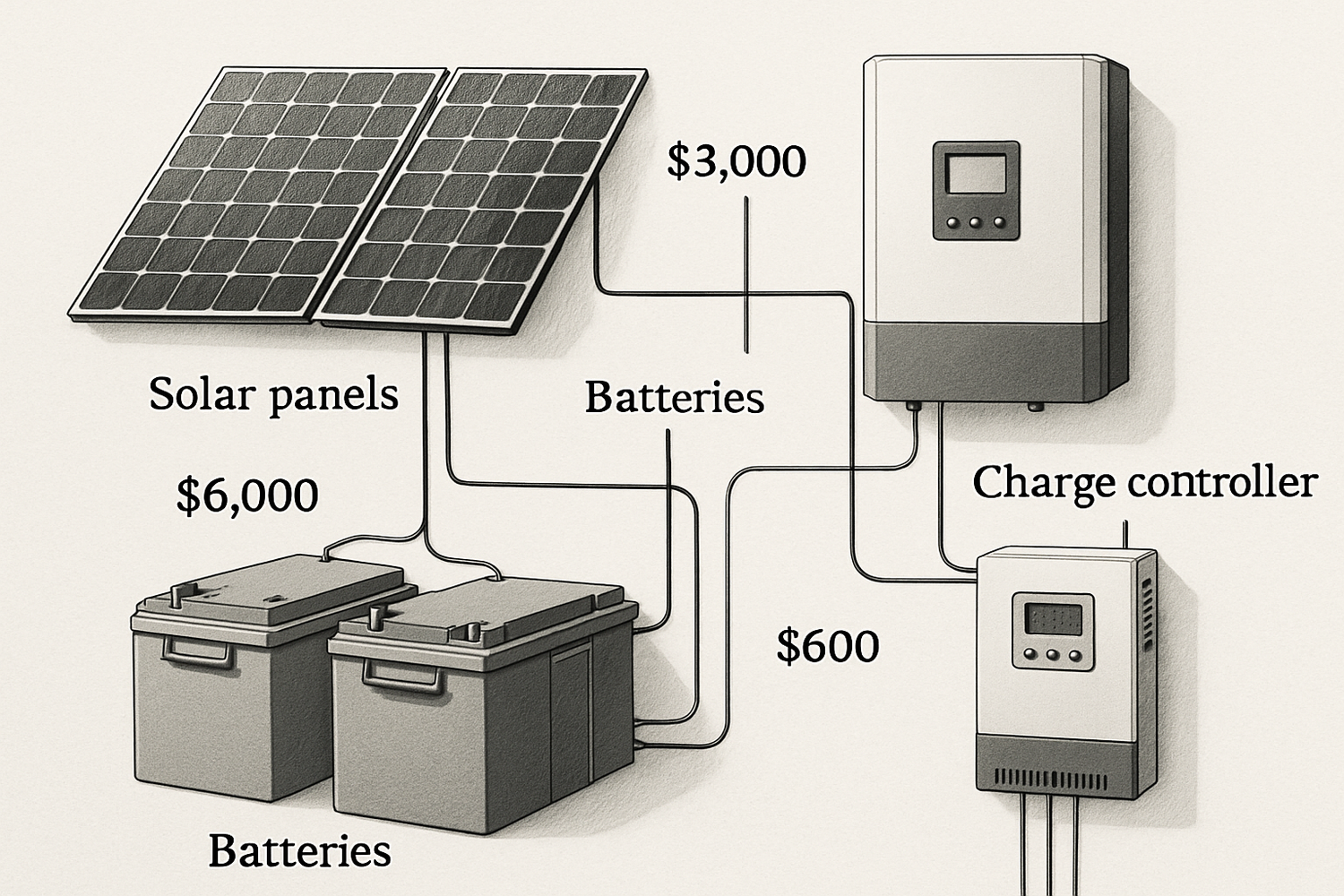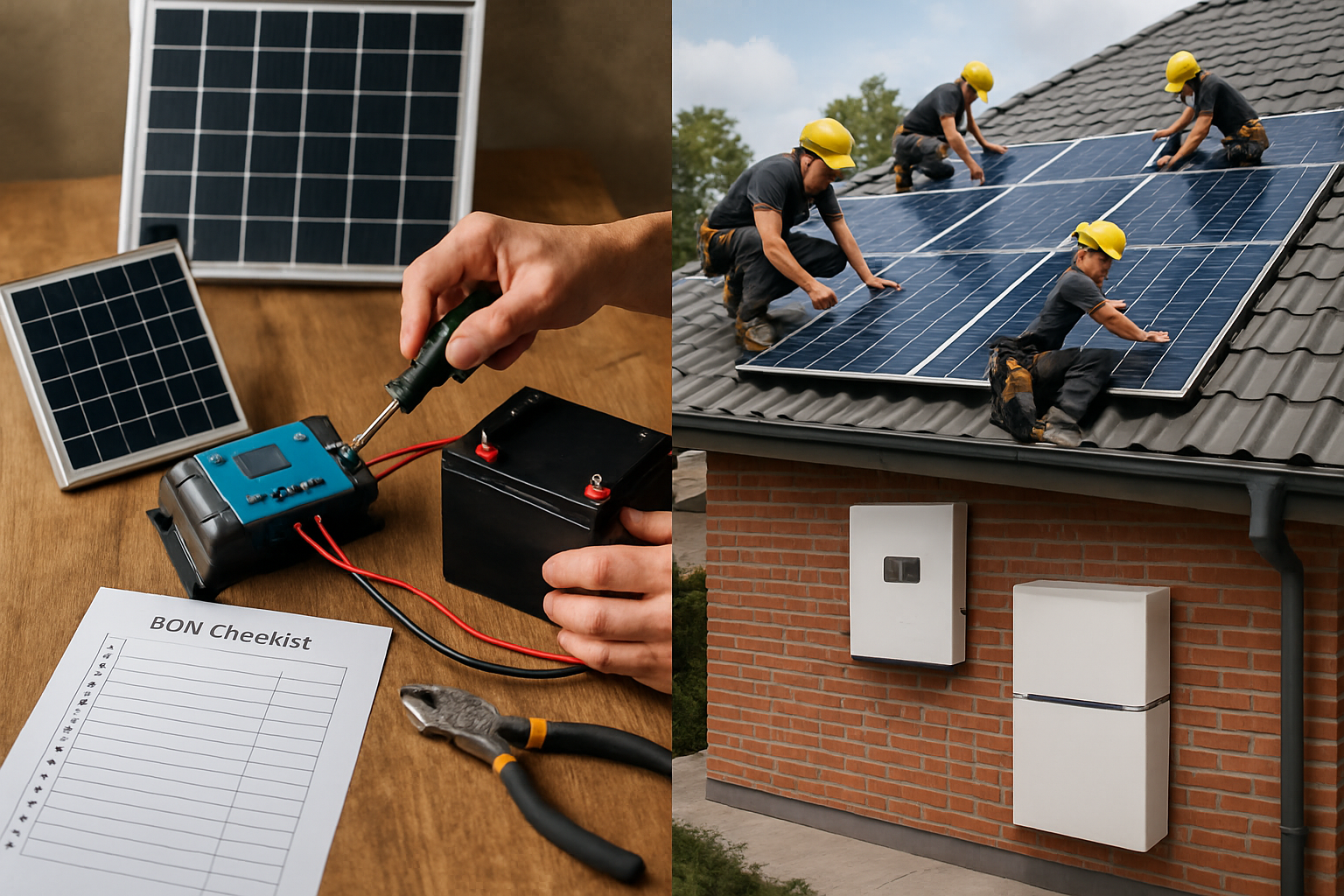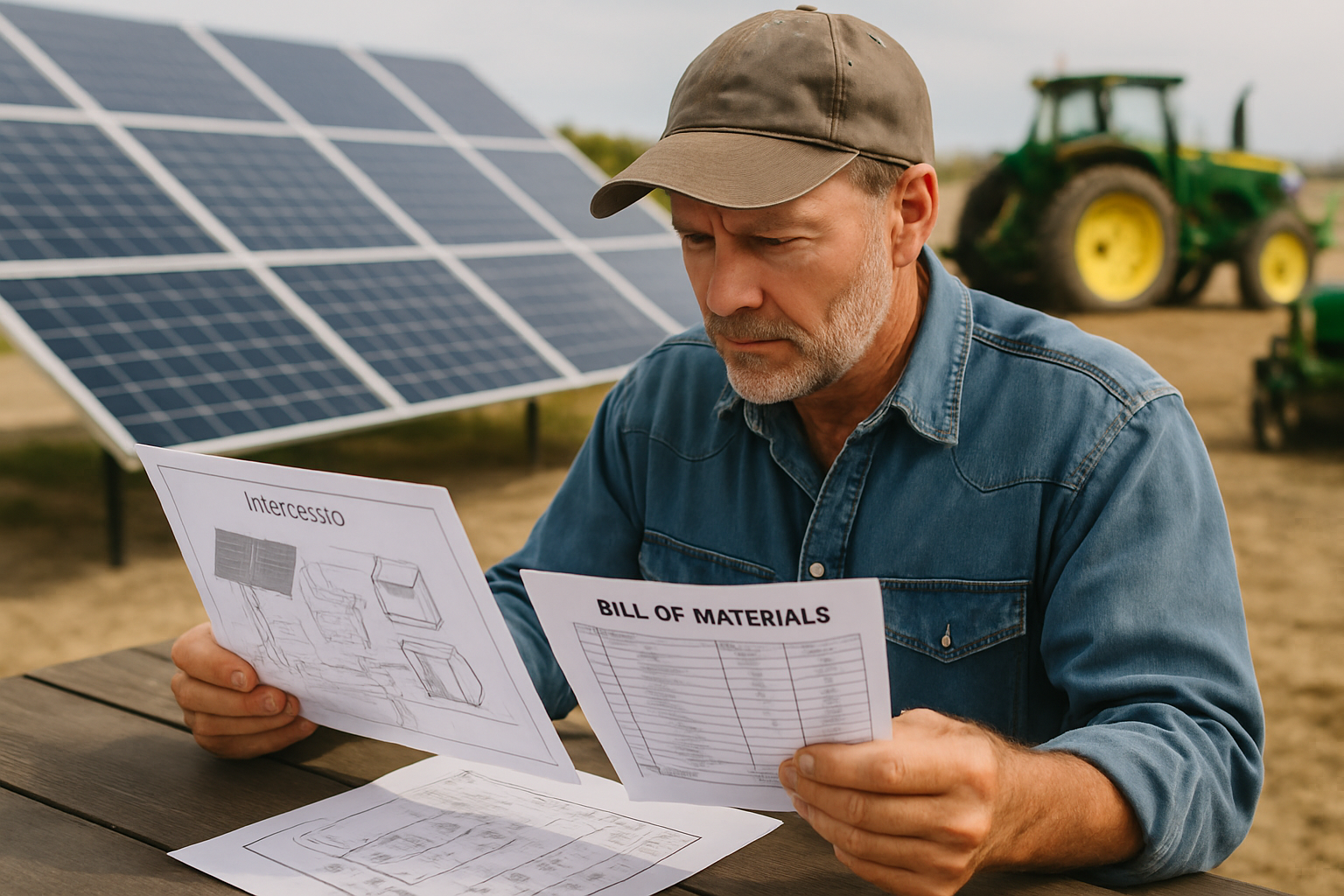Building your own off-grid energy storage system (ESS) offers a compelling path to energy independence and significant cost control. A detailed Bill of Materials (BOM) provides the blueprint for your project's financial success. This guide will help you navigate the complexities of BOM pricing, ensuring you make informed decisions for a robust and cost-effective off-grid setup.

Deconstructing the Off-Grid ESS Bill of Materials
A comprehensive BOM lists every component needed for your off-grid ESS. Understanding each part's function and cost impact is the first step toward effective budgeting, providing clarity on where your investment goes.
Core Components and Their Role
- Solar Photovoltaic (PV) Panels: These devices convert sunlight into usable electricity. Their cost varies based on wattage, efficiency ratings, and the manufacturer. According to the Solar Futures Study, global average selling prices for PV modules have experienced various trends, influencing overall system costs .
- Energy Storage Batteries: The core of any off-grid system, batteries store surplus energy generated by solar panels for use during periods without sunlight. Lithium iron phosphate (LiFePO4) batteries are a popular choice due to their high performance, inherent safety features, and extended cycle life, often exceeding 6,000 cycles at 80% depth of discharge. The Solar Futures Study provides projections for 4-hour battery storage upfront and O&M costs, underscoring the significant financial commitment in this area .
- Hybrid Inverter: This crucial component converts the direct current (DC) electricity from your solar panels and batteries into alternating current (AC) suitable for household appliances. Hybrid inverters also intelligently manage the flow of power between the solar array, battery bank, and your electrical loads, often integrating the charge controller function.
- Charge Controller: If not integrated into a hybrid inverter, a standalone charge controller regulates the voltage and current from solar panels to the batteries. This prevents overcharging, which can damage batteries, and helps extend their operational lifespan. MPPT (Maximum Power Point Tracking) controllers are generally more efficient than PWM (Pulse Width Modulation) types, especially in conditions with varying sunlight, justifying their higher price point with better energy harvest.
-
Balance of System (BOS) Components: This broad category encompasses all the smaller, yet equally vital, items that connect and protect your system:
- Mounting Hardware: This includes the racks, rails, and clamps necessary for securely installing solar panels on roofs or ground arrays.
- Wiring and Cabling: Proper DC and AC cables, sized appropriately for current loads and lengths, minimize energy loss and ensure safety.
- Circuit Breakers and Fuses: These are critical safety devices designed to protect components from overcurrents and short circuits, preventing damage and fire hazards.
- Disconnect Switches: Manual switches allow for safe isolation of different parts of the system, which is essential for maintenance, troubleshooting, and emergencies.
- Enclosures: Weatherproof enclosures protect electrical components like charge controllers and wiring connections from environmental elements.
Understanding Component Specifications and Compatibility
Each component in an off-grid ESS has specific technical ratings that dictate its performance and how it integrates with other parts of the system. You must ensure perfect compatibility across your system's voltage (e.g., 12V, 24V, 48V), current, and power ratings (watts, kilowatts). For instance, a 48V battery bank requires a 48V compatible inverter and charge controller to operate correctly and safely. Mismatched components can lead to reduced efficiency, premature component failure, or even pose serious safety risks. Diligently reviewing technical datasheets and meticulously planning your system's architecture prevents costly errors and ensures optimal performance.
Strategic Sourcing and Cost Optimization
Optimizing your BOM pricing involves more than just finding the lowest price; it requires strategic sourcing and a keen understanding of value. The objective is to acquire high-quality, reliable components without unnecessary expenditure.
Navigating Supplier Options and Pricing Structures
You have several avenues for sourcing the components for your off-grid ESS:
- Direct from Manufacturers: For major components like LiFePO4 batteries and inverters, purchasing directly can sometimes offer competitive pricing, especially for larger quantities. This approach often provides direct access to comprehensive technical support and streamlined warranty services. Our company, with extensive experience in the solar industry and a focus on lithium battery manufacturing and integrated ESS development, provides high-performance, safe, and reliable LiFePO4 batteries directly to customers.
- Specialized Distributors: These companies often stock a wide range of reputable brands and can offer bundled deals or valuable technical advice. They can simplify logistics by consolidating orders from multiple manufacturers.
- Online Retailers and Marketplaces: These platforms offer convenience and a vast selection, allowing for easy price comparisons. However, you must exercise caution by carefully vetting sellers, scrutinizing product reviews, and verifying warranty information and return policies to avoid counterfeit or low-quality items.
When comparing prices, always consider the total landed cost, which includes shipping fees, applicable taxes, and potential import duties. A seemingly lower unit price can quickly become more expensive once these additional fees are factored in.
Bulk Purchasing and Negotiation Tactics
For larger off-grid systems or if you plan to build multiple systems, explore the possibility of purchasing components in bulk. Many suppliers offer significant discounts for higher volumes. Do not hesitate to request detailed quotes from several suppliers and leverage these to negotiate better prices. Clearly communicate your project's specific needs, expected quantities, and timeline to potential vendors. Understanding broader market trends, such as the general increase in capital costs for renewables observed in 2022, as highlighted in the World Energy Investment 2023 report, can also strengthen your negotiation position .
Beyond the BOM: Accounting for Hidden Costs
While the BOM meticulously lists physical components, a truly accurate cost model for an owner-built ESS must also include "soft costs" and long-term considerations that are frequently overlooked in DIY projects.
Soft Costs: Permitting, Design, and Tools
- Design and Engineering: For complex or larger systems, you might benefit from professional design assistance to ensure optimal performance, safety, and compliance with local electrical codes. This can involve detailed electrical load calculations, precise system sizing, and comprehensive wiring diagrams.
- Permitting and Inspection Fees: Depending on your geographical location and the scale of your system, you might need various permits for electrical work or structural modifications. These fees can vary significantly by jurisdiction and are a mandatory part of ensuring legality and safety.
- Specialized Tools: Constructing an ESS requires specific tools beyond standard household items. These include professional-grade crimpers for battery cables, high-quality multimeters for electrical testing, torque wrenches for secure connections, and essential personal protective equipment (PPE). While some tools can be rented, purchasing them adds to your initial outlay.
- Shipping and Logistics: Large and heavy components, such as solar panels and battery banks, incur substantial shipping costs. It is vital to factor these into your budget, especially if you are sourcing components from different vendors or international suppliers.
- Contingency Budget: Always allocate a contingency fund, typically 10-15% of your total estimated budget, to cover unforeseen expenses, minor component changes, or unexpected challenges that can arise during construction.
Long-Term Costs: Maintenance and Potential Replacements
An owner-built system requires ongoing attention and maintenance to ensure its longevity and optimal performance. This includes routine tasks such as cleaning solar panels to maximize energy harvest, regularly checking battery health, and inspecting all wiring connections for wear or corrosion. While modern LiFePO4 batteries are renowned for their exceptional longevity and minimal maintenance requirements, other components like inverters typically have a lifespan of 10-15 years and will eventually require replacement. Planning for these future expenses ensures the long-term viability and sustained cost-effectiveness of your off-grid investment. The Solar Futures Study provides projections for O&M costs for utility-scale PV and battery storage, which can offer a general perspective on long-term operational expenses across different scales .
Practical BOM Pricing Examples
Let's consider two hypothetical scenarios to illustrate the nuances of BOM pricing for owner-built off-grid ESS, offering a clearer picture of potential investments.
Small Cabin System BOM Breakdown (e.g., 1-2 kWh daily usage)
For a modest cabin or small remote setup requiring basic lighting, phone charging, and occasional use of small appliances, a compact system might involve the following:
| Component | Quantity | Estimated Cost Range (USD) | Notes |
|---|---|---|---|
| Solar Panels (300W-400W) | 2 | $300 - $600 | Depends on efficiency, brand, and market availability. |
| LiFePO4 Battery (5 kWh) | 1 | $1,500 - $2,500 | Offers high cycle life and reliable performance for daily use. |
| Hybrid Inverter (1.5 kW) | 1 | $500 - $1,000 | Often includes an integrated charge controller, simplifying the system. |
| Mounting Hardware | 1 set | $100 - $200 | Suitable for roof or ground mount, depending on site specifics. |
| Wiring, Fuses, Breakers | 1 set | $150 - $300 | Essential for safety and proper electrical connectivity. |
| Subtotal BOM | $2,550 - $4,600 | ||
| Soft Costs (estimate 15%) | $380 - $690 | Covers specialized tools, shipping, and minor permits. | |
| Total Estimated Cost | $2,930 - $5,290 |
This example provides a general idea for a small, owner-built system. Actual costs will vary considerably based on specific component choices, chosen suppliers, and regional pricing dynamics. The Solar Futures Study benchmarked upfront system costs for various PV market segments in 2020, offering a valuable reference for panel-related expenses .
Larger Home System BOM Considerations (e.g., 10-20 kWh daily usage)
For a larger home with higher energy demands, powering multiple appliances and extended usage, the system components and associated costs scale up significantly:
| Component | Quantity | Estimated Cost Range (USD) | Notes |
|---|---|---|---|
| Solar Panels (300W-400W) | 10-15 | $1,500 - $4,500 | Required for higher power output and energy generation. |
| LiFePO4 Battery (20 kWh) | 1-2 | $6,000 - $10,000 | Often modular, allowing for future expansion as needs evolve. |
| Hybrid Inverter (5-8 kW) | 1 | $2,000 - $4,000 | Provides higher continuous power output for larger loads. |
| Mounting Hardware | 1 set | $500 - $1,000 | Accommodates a larger solar array footprint. |
| Wiring, Fuses, Breakers | 1 set | $500 - $1,000 | More complex wiring and higher current ratings for safety. |
| Subtotal BOM | $10,500 - $20,500 | ||
| Soft Costs (estimate 15%) | $1,575 - $3,075 | Likely includes design fees, more extensive permits, and specialized tools. | |
| Total Estimated Cost | $12,075 - $23,575 |
These figures are illustrative and serve as a guide. Market conditions, ongoing technology advancements, and your specific product choices will significantly influence the final costs. The World Energy Investment 2023 report indicates that while investment in clean energy is robust, some parts of the power investment chain show signs of stress, which can affect component availability and pricing, impacting your BOM .
Empowering Your Off-Grid Investment
Creating a detailed Bill of Materials is a foundational step for any owner-built off-grid ESS. By meticulously planning each component, strategically sourcing materials, and anticipating all associated costs, you gain significant control over your project's budget and outcome. This comprehensive approach empowers you to build a reliable, efficient, and cost-effective energy solution tailored to your specific needs, fostering true energy independence and long-term sustainability.
Frequently Asked Questions (FAQ)
What is a Bill of Materials (BOM) for an off-grid ESS?
A BOM is a comprehensive list of all raw materials, components, and sub-assemblies required to construct your off-grid energy storage system. It includes everything from solar panels and batteries to wires, fuses, and mounting hardware, serving as a complete inventory for your build.
How can I reduce the cost of my off-grid ESS BOM?
You can reduce costs by comparing prices from multiple reputable suppliers, considering bulk purchases for larger systems, and selecting components that offer the best balance of performance, durability, and value. Prioritizing high-quality, long-lasting components like LiFePO4 batteries can also significantly reduce long-term replacement and maintenance costs.
What are "soft costs" in an off-grid ESS project?
Soft costs are expenses beyond the physical components listed in your BOM. They typically include design and engineering fees, permitting and inspection costs, the purchase or rental of specialized tools, shipping and logistics, and a crucial contingency budget for unforeseen issues.
Is it always cheaper to build my own off-grid ESS?
While a DIY approach can offer substantial savings on professional labor and installation fees, it demands a significant investment of your time, extensive research, and specific technical skills. When you account for soft costs, the potential for costly mistakes, and the value of your own time, the financial difference between a DIY build and a professional turnkey solution can sometimes narrow. A detailed BOM helps you accurately assess the true financial commitment of a DIY project.
How important is component compatibility in an off-grid system?
Component compatibility is critically important for the safe, efficient, and reliable operation of your off-grid system. Mismatched voltages, currents, power ratings, or communication protocols between components can lead to system malfunction, reduced efficiency, premature component damage, or even serious safety risks. Always verify that all major components are designed to work together seamlessly and adhere to industry standards.
References
- World Energy Investment 2023. IEA. Published 2023-05-28.
- Solar Futures Study. U.S. Department of Energy.





Leave a comment
All comments are moderated before being published.
This site is protected by hCaptcha and the hCaptcha Privacy Policy and Terms of Service apply.